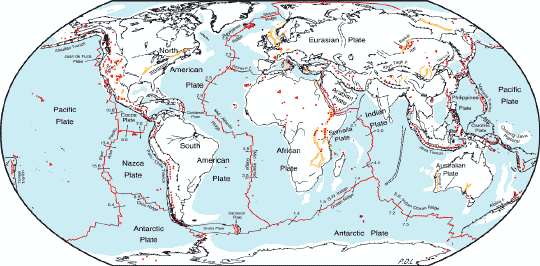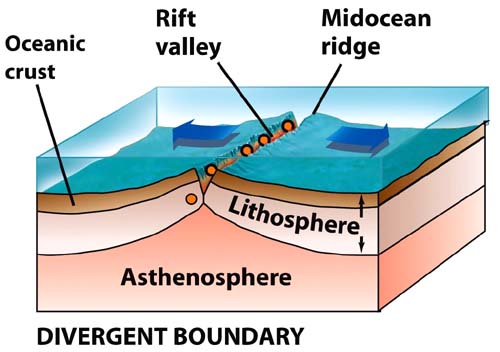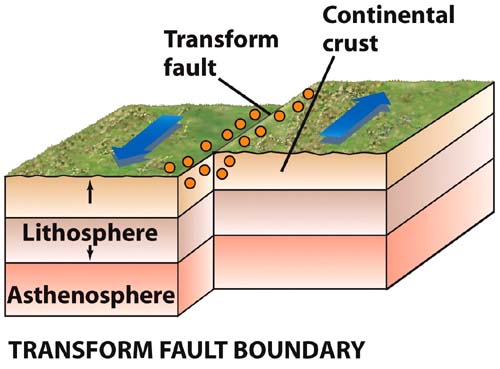Plate tectonics and basin formation
Plate tectonics regards the lithosphere broken into plate that are in motion. The plates move relative to another along plate boundaries, sliding upon the underlying asthenosphere (the layer below the lithosphere that is formed of molten rock). The theory of plate tectonics emerged since the 1960s, and until now this theory has successfully explained various geological events, such as earthquakes, tsunamis, and volcanic eruption, also explained how the formation of mountains, continents, and oceans.

List of Tectonic Plates [2]
The lithosphere is divided into several tectonic plates intersect with each other. Here are the names of tectonic plates on the Earth:
Major Plates (≥10 million km2)
These ten plates comprise the bulk of the continents and the Pacific Ocean.
- Pacific Plate – 103,300,000 km2
- North American Plate – 75,900,000 km2
- Eurasian Plate – 67,800,000 km2
- African Plate – 61,300,000 km2
- Antarctic Plate – 60,900,000 km2
- Australian Plate – 47,000,000 km2
- South American Plate – 43,600,000 km2
- Somali Plate – 16,700,000 km2
- Nazca Plate – 15,600,000 km2
- Indian Plate – 11,900,000 km2
Minor Plates (≥ 1 million km2, ≤ 10 million km2)
- Philippine Sea Plate – 5,500,000 km2
- Arabian Plate – 5,000,000 km2
- Caribbean Plate – 3,300,000 km2
- Cocos Plate – 2,900,000 km2
- Caroline Plate – 1,700,000 km2
- Scotia Plate – 1,600,000 km2
- Burma Plate – 1,100,000 km2
- New Hebrides Plate – 1,100,000 km2
Micro Plates (≤ 1 million km2)
African Plate
- Lwandle Plate
- Rovuma Plate
- Seychelles Plate
- Victoria Plate
Antarctic Plate
- Kerguelen microcontinent
- Shetland Plate
- South Sandwich Plate
Caribbean Plate
- Panama Plate
- Gonâve Microplate
Cocos Plate
- Rivera Plate
Eurasian Plate
- Adriatic or Apulian Plate
- Aegean Sea Plate (or Hellenic Plate)
- Amurian Plate
- Anatolian Plate
- Azores Microplate[5]
- Banda Sea Plate
- Iberian Plate
- Iranian Plate
- Molucca Sea Plate
- Halmahera Plate
- Sangihe Plate
- Okinawa Plate
- Pelso Plate
- Sunda Plate
- Timor Plate
- Tisza Plate
- Yangtze Plate
Australian Plate
- Capricorn Plate
- Futuna Plate
- Indian Plate
- Kermadec Plate
- Maoke Plate
- Niuafo'ou Plate
- Sri Lanka Plate
- Tonga Plate
- Woodlark Plate
Juan de Fuca Plate
- Explorer Plate
- Gorda Plate
North American Plate
- Greenland Plate
- Okhotsk Plate
Pacific Plate
- Balmoral Reef Plate
- Bird's Head Plate
- Caroline Plate
- Conway Reef Plate
- Easter Plate
- Galapagos Plate
- Juan Fernandez Plate
- Kula Plate
- Manus Plate
- New Hebrides Plate
- North Bismarck Plate
- North Galapagos MicroPlate
- Solomon Sea Plate
- South Bismarck Plate
Philippine Sea Plate
- Mariana Plate
- Philippine Microplate
South American Plate
- Altiplano Plate
- Falklands Microplate
- North Andes Plate
Plate Movements
The tectonic plates of the earth is not stationary, but moves relative with the speed of 1 to 10 cm per year. The movement of the earth's crustal plates that collide with each other will form the subduction zone and cause the forces acting both horizontally and vertically, which will form the folds of the mountains, volcanoes track or magmatic, fracturing the rock, and the lines of tectonic earthquakes and the formation of a particular region. Moreover, that will also form various types of deposition of sedimentary basins such as trench, fore arc basin, back arc basin, and basin between the mountains.
Plate Boundaries
Based on the direction of its movement, the plate boundary between tectonic plates with the other plate boundaries are divided into three types.
Divergent Plate Boundaries
Divergent plate boundaries occurs on two tectonic plates are break apart. When a broken plate tectonics, lithospheric thinning layer and split, forming divergent boundaries. In the ocean plate, this process causes the seafloor spreading. While on the continental shelf, this process causes the formation of rift valley due to the gap between the two plates which are away from each other. Mid-Atlantic Ridge is one of the most famous examples of divergent, stretching from north to south along the Atlantic Ocean, restricting the Continent of Europe and Africa to the Americas.

Transform Boundaries
At transform boundaries, one plate slides horizontally past another plate, the plate can occur on a single fault or on a group of parallel faults. Transform boundary is also known as transform fault. The most common type of transform fault occurs along fracture zones and connect two divergent plate boundaries at the crest of the mid-oceanic ridge. The example of transform boundaries is the friction between the plates of the Pacific Ocean to the North American mainland plate which resulted the formation of the San Andreas Fault which extends along approximately 1,200 km from San Francisco in the north to the south of Los Angeles in the United States.

Convergent Plate Boundaries
Convergent plate boundaries are the collisions between tectonic plates. The collisions between tectonic plates can be distinguished into ocean-ocean convergent, ocean-continent convergent, or continent-continent convergent. The character of the boundary depends partly on the type of plates that converge. In ocean-ocean convergent, a plate can move toward another plate, where one plate subducts under the other. While, in ocean-continent convergent, the dense oceanic plate subducts under the continental plate. In continent-continent convergent, the two approaching plate collide and crumple but neither is subducted.